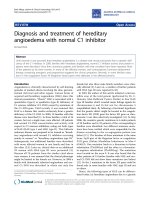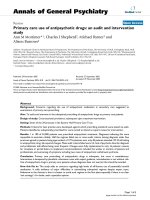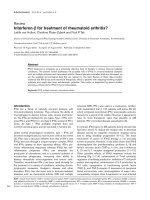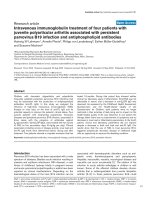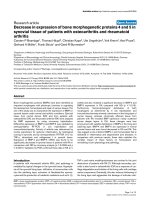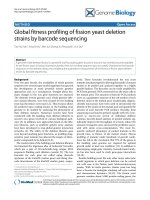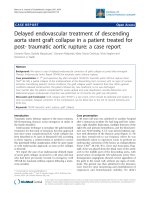Báo cáo y học: " Duloxetine in treatment of refractory chronic tennis elbow: Two case reports" ppt
Bạn đang xem bản rút gọn của tài liệu. Xem và tải ngay bản đầy đủ của tài liệu tại đây (189.43 KB, 3 trang )
BioMed Central
Page 1 of 3
(page number not for citation purposes)
Journal of Medical Case Reports
Open Access
Case report
Duloxetine in treatment of refractory chronic tennis elbow: Two
case reports
Zaid Ahmad Wani*
1
, Shabir Ahmad Dhar
2
, Mohammad Farooq Butt
2
,
Yasir Hassan Rather
1
and Shano Sheikh
3
Address:
1
Department of Psychiatry, Government Psychiatric Diseases Hospital, GMC Srinagar, Kashmir, J&K, 190010, India,
2
Department of
Orthopaedics, GMC Srinagar, Kashmir, J&K, 190010, India and
3
Department of Psychology, Jamia Milia Islamia, Jamia Nagar, New Delhi, 110025,
India
Email: Zaid Ahmad Wani* - ; Shabir Ahmad Dhar - ;
Mohammad Farooq Butt - ; Yasir Hassan Rather - ; Shano Sheikh -
* Corresponding author
Abstract
Introduction: Tennis elbow is a common musculoskeletal disorder; management options include
physiotherapeutic, medical, surgical, and other forms of intervention. Some patients remain
symptomatic despite best efforts. We present two patients who did not respond to medical and
surgical treatments, and whose symptoms were relieved with duloxetine. This is the first report on
the use of duloxetine to treat tennis elbow.
Case presentation: Two mentally healthy young Asian women aged 32 and 27 years, each with
tennis elbow of about 18 months duration continued to suffer pain despite treatment with
analgesics, local steroid injections, physiotherapy, cryotherapy, ultrasound, and surgical release,
among other interventions. Both showed substantial improvement within 4 to 6 weeks of receiving
monotherapy with duloxetine 60 mg/day. Both were pain-free with continued treatment at a 6-
month follow-up.
Conclusion: Duloxetine may be a useful treatment option in patients with chronic tennis elbow,
even those who have failed conventional medical, physiotherapeutic, surgical, and other forms of
management.
Introduction
Lateral epicondylalgia or tennis elbow is a common cause
of pain and disability; it often develops in non-athletes. It
is characterized by pain and tenderness centered around
the lateral epicondyle. The source of the pain was initially
thought to be due to extensor carpi radialis brevis degen-
eration. However, it is now recognized that the lateral epi-
condyle, the annular ligament, the radial head and the
capitellum may also contribute to the experience of pain
in tennis elbow [1].
Several factors have been implicated in the causation of
tennis elbow. These include overuse of the affected limb,
repetitive forceful movements, training errors, misalign-
ments, flexibility problems, ageing, poor circulation,
strength deficits and muscle imbalances [2,3].
Tennis elbow can be difficult to treat. The condition is
prone to recurrence, and the symptoms may last for sev-
eral weeks or months, with the average duration of a typ-
ical episode reported to be between 6 months and 2 years
Published: 17 September 2008
Journal of Medical Case Reports 2008, 2:305 doi:10.1186/1752-1947-2-305
Received: 1 March 2008
Accepted: 17 September 2008
This article is available from: />© 2008 Wani et al; licensee BioMed Central Ltd.
This is an Open Access article distributed under the terms of the Creative Commons Attribution License ( />),
which permits unrestricted use, distribution, and reproduction in any medium, provided the original work is properly cited.
Journal of Medical Case Reports 2008, 2:305 />Page 2 of 3
(page number not for citation purposes)
[4]. Non-operative treatment is successful in effecting a
resolution of symptoms in most patients. Such conserva-
tive treatment options include analgesics, tennis elbow
support, ultrasonic therapy, and splint immobilization.
Local corticosteroid injections, local autologous blood
infiltration, laser therapy, and nitrogen cryotherapy have
been used as semi-conservative methods [4,5]. All of these
aim at reducing the pain and improving the functional
status of the affected limb. Surgery is offered to resistant
cases; outcomes are not always successful [6].
Duloxetine is an antidepressant which acts by serotonin
and noradrenalin reuptake inhibition [7]. Duloxetine has
been found to be helpful in patients with painful diabetic
neuropathy [8] and fibromyalgia [9]. We hypothesized
that duloxetine may benefit two patients who were
referred to us for the management of chronic, refractory
tennis elbow. To the best of our knowledge, this is the first
report on the use of duloxetine to treat tennis elbow.
Case presentation 1
A 32-year-old woman, presented with symptoms of tennis
elbow of the right limb of 18 months duration. She had
been treated with analgesics, splint immobilization and
rest, local steroid infiltrations, ultrasonic therapy and
autologous blood infiltration over a period of 1 year. She
had also undergone lateral tendon release 7 months ear-
lier. A psychiatric evaluation was sought because of the
unrelenting nature of the pain arising from the common
extensor muscles of the forearm. Physical examination
showed tenderness just distal and anterior to the lateral
epicondyle along with pain with resisted wrist extension
with elbow in full extension. Clinical interview identified
no Axis I psychiatric disorder. The pain on the visual ana-
logue scale (VAS) was about 70–75 mm, with 0 being
none and 100 being maximum pain. The initial Nirschl
stage was 5 [10].
She was prescribed duloxetine in a dose that was increased
to 60 mg per day over 5 days; analgesic treatment was
stopped. She reported a gradual reduction in pain; VAS
scores dropped to 40 after 3 weeks, and to 25 after 4
weeks. She was substantially pain-free after 6 weeks of
treatment. The tests for elbow tendinosis, including
resisted wrist extension and supination and 3rd digit
extension, did not produce pain. The Nirschl stage was 2.
Case presentation 2
A 27-year-old woman was diagnosed with right-sided ten-
nis elbow of 18 months duration. She had been treated
with analgesics, plaster immobilization, multiple steroid
infiltrations, cryotherapy, ultrasonic therapy, and pro-
longed brace wear. She had experienced limited pain relief
lasting for less than a fortnight on most occasions. Nirschl
tendon release was done after the conservative methods
failed. She experienced partial pain relief for 4 weeks but
again developed pain. She was referred for a psychiatric
evaluation but this did not reveal any Axis I psychiatric
disorder. The pain on VAS was 65–70 mm with a Nirschl
stage of 4.
She was prescribed duloxetine 60 mg/day. After 4 weeks,
the VAS score had dropped to 30. The tests for elbow tend-
inosis, including resisted wrist extension and supination
and third digit extension, did not produce pain. The Nir-
schl stage was 2.
Both patients continued with duloxetine to a 6-month fol-
low-up, at which time VAS scores were recorded as zero.
Discussion
Chronic pain compromises quality-of-life and impairs
work performance. While a cure may not be feasible, treat-
ment efforts should aim for pain relief and improvement
in the quality-of-life.
Pain is transmitted from peripheral sites along two sets of
afferent nerves, that is, the A delta and C fibers. These syn-
apse in the dorsal horn of the spinal cord. Preliminary
processing of pain information occurs here before trans-
mission through ascending tracts to the thalamus and
higher brain centers. Pain information however, can be
modulated by the activity of descending inhibitory fibers
passing from the brain to the spinal cord. The neurotrans-
mitters primarily involved in the descending pathways,
that is, norepinephrine and serotonin, act synergistically
in reducing the transmission of pain information from the
periphery to the central nervous system [11,12]. Analgesia
produced by antidepressants is thought to be mediated by
enhanced activity of norepinephrine and serotonin in
descending fibers [13]. Some antidepressants also inhibit
sodium-channel function, which can dampen the activity
of pain-relaying neurons [14]. Enhanced activity of nore-
pinephrine and serotonin in descending fibers as a result
of duloxetine administration could have resulted in the
improvements observed in the two cases reported. We
speculate that these effects raise the pain threshold in the
affected patients, leading to a decreased perception of
pain. We are, however, unable to explain the maintained
state of recovery of both patients, which must have
involved a reversal of the pathology locally.
Conclusion
Duloxetine may relieve pain in patients with chronic ten-
nis elbow, including those who have failed to respond to
medical, physiotherapeutic, surgical, and other interven-
tions. The benefits of duloxetine and its impact on the
pathology of the disorder merit investigation in prospec-
tive clinical trials.
Publish with BioMed Central and every
scientist can read your work free of charge
"BioMed Central will be the most significant development for
disseminating the results of biomedical research in our lifetime."
Sir Paul Nurse, Cancer Research UK
Your research papers will be:
available free of charge to the entire biomedical community
peer reviewed and published immediately upon acceptance
cited in PubMed and archived on PubMed Central
yours — you keep the copyright
Submit your manuscript here:
/>BioMedcentral
Journal of Medical Case Reports 2008, 2:305 />Page 3 of 3
(page number not for citation purposes)
Consent
Written informed consent was obtained from both
patients for publication of these case reports. Copies of
the written consent are available for review by the Editor-
in-Chief of this journal.
Competing interests
The authors declare that they have no competing interests.
Authors' contributions
ZAW reviewed the literature, and conceived of and drafted
the manuscript; YHR performed the psychiatric assess-
ment of the patients including the follow-up. SAD and
MFB were responsible for the orthopedic assessment and
revision of the paper. SS performed the psychological
assessment of the patients. All authors read and approved
the final manuscript.
References
1. Christian CA: Shoulder and elbow injuries. In Campbell's Opera-
tive Orthopaedics Volume 2. 9th edition. Edited by: Canale ST. St. Louis,
MO: Mosby;; 1998:1321-1328.
2. Almekinders LC, Temple JD: Etiology, diagnosis, and treatment
of tendonitis: an analysis of the literature. Med Sci Sports Exerc
1998, 30:1183-1190.
3. Kamien M: A rational management of tennis elbow. Sports Med
1990, 9:173-191.
4. Murtagh J: Tennis elbow. Aust Fam Physician 1988, 17:90, 91, 94-95.
5. Coonrad RW, Hooper WR: Tennis elbow: its course, natural
history, conservative and surgical management. J Bone Joint
Surg Am 1973, 55:1177-1182.
6. Buchbinder R, Green S, Struijs P: Tennis elbow. Clin Evid 2007,
16:508-10.
7. Westanmo AD, Gayken J, Haight R: Duloxetine: a balanced and
selective norepinephrine- and serotonin-reuptake inhibitor.
Am J Health Syst Pharm 2005, 62:2481-2490.
8. Goldstein DJ, Lu Y, Detke MJ, Lee TC, Iyengar S: Duloxetine vs.
placebo in patients with painful diabetic neuropathy. Pain
2005, 116(1–2):109-118.
9. Arnold LM, Lu Y, Crofford LJ, Wohlreich M, Detke MJ, Iyengar S,
Goldstein DJ: A double blind multicenter trial comparing
duloxetine with placebo in the treatment of fibromyalgia
patients with or without major depressive disorder. Arthritis
Rheum 2004, 50(9):2974-2984.
10. Nirschl RP, Sobel J: Arm Care: A Complete Guide to Prevention and Treat-
ment of Tennis Elbow Arlington, VA: Medical Sports Inc; 1996.
11. DeLander GE, Hopkins CJ: Interdependence of spinal adenosin-
ergic, serotonergic and noradrenergic systems mediating
antinociception. Neuropharmacology 1987, 26:1791-1794.
12. Fields HL, Heinricher MM, Mason P: Neurotransmitters in nocic-
eptive modulatory circuits. Annu Rev Neurosci 1991, 14:219-245.
13. DeLander GE, Hopkins CJ: Interdependence of spinal adenosin-
ergic, serotonergic and noradrenergic systems mediating
antinociception. Neuropharmacology 1987, 26:1791-1794.
14. Barkin RL, Fawcett J: The management challenges of chronic
pain: the role of antidepressants. Am J Ther 2000, 7:31-47.
